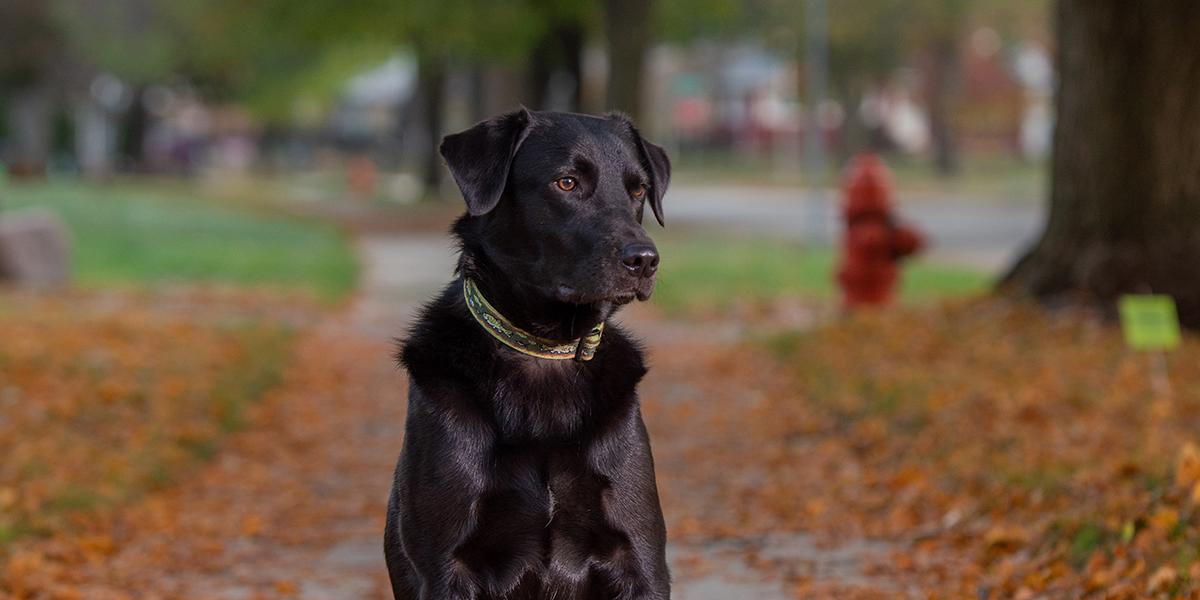Rudy's chances
Labrador receives a second chance to thrive following a historic cardiac procedure.

Labrador receives a second chance to thrive following a historic cardiac procedure.
Rudy
As a puppy, Rudy preferred a secluded place to hide from his romping litter mates. When Jill and Chris Carter saw Rudy in the adoption shelter, their hearts went out to him.
“His brothers and sisters would not allow him to hide,” Jill remembers. “Chris noticed that he was being drug out from his hiding place by his tail and being forced to join the puppy fun fest.”
The Rochester, Minn., couple adopted Rudy and his sister, which they named Holly. Two weeks later when the Carters picked them up, the differences were striking. Rudy weighed 5 pounds while Holly had grown to 11 pounds. And Rudy appeared bloated.
Their veterinarian recommended deworming, which didn’t help. “Holly was growing like a weed, but Rudy was rounder and not really growing,” Jill says.
A trip to the emergency room confirmed a significant amount of abdominal fluid. Liver problems were the suspected cause. An abdominal CT eliminated that theory. Rudy’s liver was struggling, but in good shape. But at the edge of the scan the radiologist spotted abnormalities with his inferior vena cava—the vessel that returns blood from the lower and middle parts of the body to the right atrium of the heart. A chest CT revealed a membrane separating Rudy’s right atrium into two chambers. The malfunctioning atrium had caused the incoming inferior vena cava to balloon out as blood pooled.
Called cor triatriatum dexter, or CTD, the condition occurs when an embryonic structure persists after birth to form the membrane. The rare abnormality is well-documented in humans and other animals, and patients often have other heart defects. The poor circulation leads to congestion as fluid collects in the abdominal cavity.
The vet told us we were in luck because there was a cardiologist at the University of Minnesota who specializes in CTD cases.
Jill Carter
“The vet told us we were in luck because there was a cardiologist at the University of Minnesota who specializes in CTD cases,” Jill says. An appointment with Chris Stauthammer, DVM, Diplomate ACVIM (Cardiology), was made and a treatment plan was developed.
“Our typical method is to use a catheter to insert a device into the atrium to either stretch the membrane or perforate it to increase blood flow throughout the atrium,” Stauthammer says.
Surgery day came and the Carters were on edge. After seven hours, surgery was halted because the “usual” intervention wasn’t working. Rudy’s blood pressure was dropping.
“We were heart-broken,” Jill says. “We brought Rudy home and thought he would just have a month left in his short little life.” A couple of days later, Stauthammer called to say he was ready to give Rudy another chance to thrive.
Stauthammer had found a Colorado-based company that was willing to donate a transseptal needle to the College of Veterinary Medicine. The device uses radiofrequency energy to pierce thick membranes in a safe and controlled manner without using force to push through the tissue. Rudy had few remaining options, and Stauthammer’s review of human cases in the medical literature found a positive record of success.
“The transseptal needle was a logical choice because it has proved to be safer, more efficient and faster, especially in cases like Rudy’s where the membrane is thick,” Stauthammer says. “This procedure also appears to decrease the need for second attempts, which would have been dangerous for Rudy.”
Stauthammer recommended a second surgery, and the Carters agreed. It would be the first documented use of the device and procedure in a veterinary patient.
Rudy’s “second chance” surgery went smoothly. After a couple of lingering bouts of abdominal congestion, Rudy began to thrive. Jill says, “We had a healthy little puppy that could finally keep up with his sister and play.”
In October of 2020, Rudy’s checkup with Stauthammer at the Veterinary Medical Center was a breeze compared to earlier veterinary appointments that are seared into the Carterr’s memories. At two years of age, Rudy has become the brave, vocal member of their family—being the first to go outside at night to check for scary things for his sister, Holly. He welcomes the Carters home with a playful bark. The greeting brings tears to Jill’s eyes when she imagines their house without Rudy.
We will be forever grateful to the University for not giving up on Rudy. They went above and beyond expectations to make sure we will have two dogs to cuddle with.
Jill Carter
“We will be forever grateful to the University for not giving up on Rudy,” she says. “They went above and beyond expectations to make sure we will have two dogs to cuddle with.
“Every aspect of Rudy’s treatment seemed to have obstacles,” adds Carter. “It was comforting to work with the staff of the University who, from our first visit, made us feel we were in the right place.”